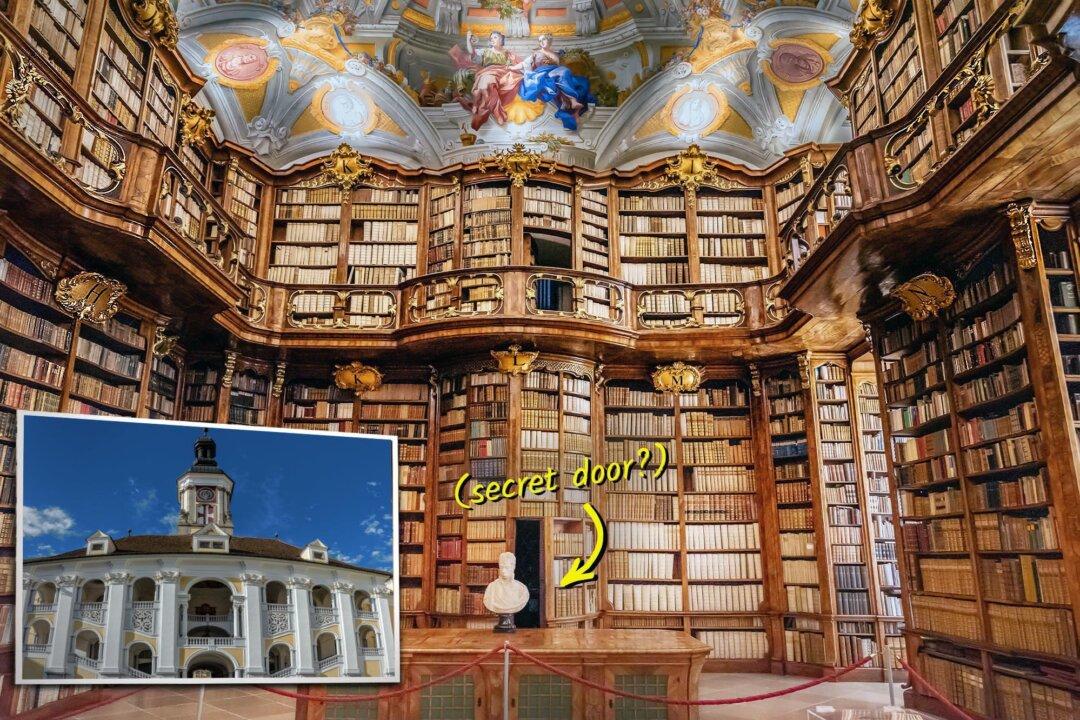There is a very old, extravagant, beautiful church along the Danube River in Northern Austria that could easily be imagined into some future Indiana Jones film—it has just the right mix of creepiness and secrecy.
With its hidden doors and secret staircases, crypt full of skulls, and thousands of tomes yellowed with age, an alluring monastery near the town of Sankt Florian, 10 miles from Linz, may conjure that fedora-wearing archeologist, whip in hand. It even had his nemeses, the Germans, occupying during the war years.
Surpassing the blockbuster movie, though, St. Florian Monastery gives the effect of transcendent beauty drawn from the Baroque style. Art and architecture elevate the mind.
The austere monks who prayed here in Carolingian times in the 9th century lived with less than the monastics who worshipped later, amid lavish halls of colored marble and ornate bookshelves. The monastery’s grand refurbishment in the 17th-century introduced the Baroque style.
St. Florian is among the largest monasteries in Austria, rivaling the towering heights of Melk Abbey and opulent decoration of Klosterneuburg Monastery. But unlike these two, St. Florian host smaller crowds.


It was christened after the Roman commander Florian, of the 1st century A.D., who converted to Christianity, and who refused to enforce Roman laws that would persecute his Christian brothers and sisters. Florian was threatened with fire, but ultimately was executed by drowning as he stoically expressed his preference for a fiery death.
He later became the patron saint of firefighters.
Visitors on the Danube River who arrive at the complex will find it as it had been after rebuilding from 1686 to 1708, by Italian architect Carlo Antonio Carlone. It was finished after his death by Jakob Prandtauer, an Austrian architect schooled in the Baroque style.
Passing the elegant clocktower and exuberant sculptures of the monastery’s exterior, one is whisked into a full-sensory experience that incorporates sound.
Several days a week, visitors sit in wooden pews of the nave and feel sonic vibrations resonate. The music from a great and famous organ affects the feelings as one absorbs the physical surroundings: the soaring columns, pilasters, and arches that line the nave; the vast vaulted ceilings with domes and masterfully-painted frescos of the heavens; and the apse with detailed wood carvings, gilding, and religious paintings.
And all these, affected by light, likewise, affect how we interpret the sound.


The famous Austrian composer Anton Bruckner once played as the organist. The Buckner Organ, as it’s called, has over 7,300 pipes and 103 stops and is one of the largest working organs in Austria.
Buckner was so in love with this music that he was entombed where he could hear the organ’s sound for eternity, right beneath where it sits. But before visitors traipse down to explore the bone-filled crypt in search of him—like our good friend Dr. Jones might—the stunning nave ceiling arrests one’s attention, impossible to ignore.
The very definition of Baroque strikes the eyes upon looking up. A painted heavenly scene seems to enter our worldly space. Faux painted colored marble columns with rotund entablatures and linear perspective create the optical illusion, helping to seamlessly blend two-dimensional myth and three-dimensional reality. This distinctly Baroque illusionism is called trompe l’oeil, French for “deceive the eye.”



Descending belowground, a stair leads to a crypt under the nave and organ, where one arrives in macabre company. Here rests a stone coffin with the remains of the organist composer Anton Bruckner still inside. He is accompanied by no fewer than 6,000 human skulls, the remains of Christians, piled neatly together in a nook behind a barred metal gate. Here a full house on the other side of death may still listen to the sounds of the organ.
Leaving the creepy crypt without lingering—tomb raiding is our friend Dr. Jones’s business—visitors can delve into the monastery’s library where artifacts and archives store ancient wisdom. And what Indiana Jones film would be complete without secret doors? The bookshelves of St. Florian have them.
Construction of the Baroque library wing of the monastery began in 1744, the work of Johann Gotthard Hayberger. Its gilded, wooden bookshelves stack from the marble floor to the second-floor balcony to the ceiling, with more colorful frescoes painted above. “The Marriage of Virtue and Science Under the Guidance of Religion,” by Bartolomeo Altomonte and Antonio Tassi, depicts allegorical scenes from heaven in pastel pinks, golds, and blues.


About 150,000 volumes from the 16th to 18th centuries and some 1,000 medieval manuscripts of the library contain more knowledge than a man will ever read. Some of the shelves swing on hidden hinges, behind which secret spiral staircases lead to balconies overlooking the library.
The journey through the complex continues, leading guests to one of the highlights for the visiting royals and dignitaries of olden days: the Imperial Marble Hall. Decked in exotic pink marble with white pillars interspersed, there are throne-like seats at one end. Here, guests of honor were treated to entertainment.
More theatrical ceiling frescos delight with allegories set in the clouds. Such illusionism was the precursor to modern special effects. The message of the Baroque movement was projected using such theatre; as today’s movies, painting, sculpture, and architecture had the power back then to spread messages en mass. So, Temple of Doom, move over. St. Florian Monastery has got all the special effects.







